SHAOLIN FLOWER SETS
Sifu Christina Didyk, Shaolin Wahnam USA
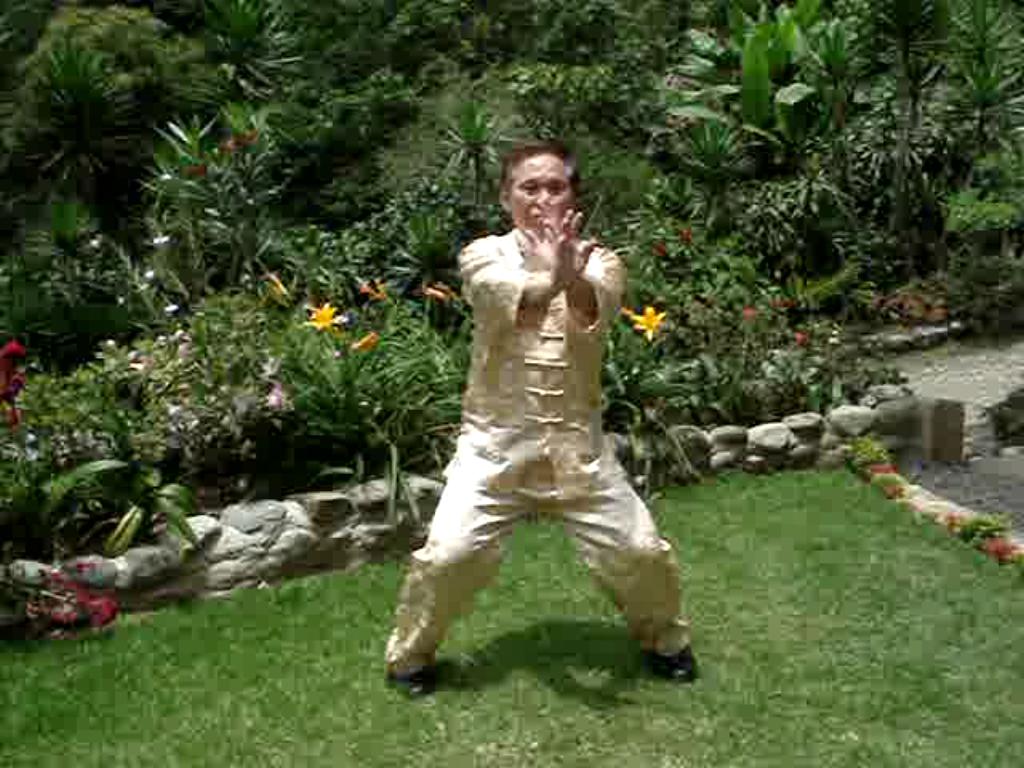
Double Worshipping of the Buddha
-
Mut yu mui fa thuei thuei hoi
Kap foong po yu khun wan loi
Blossoming like plum flowers in full gear
Swift wind rain storm clouds flowing here
Our Lineage
We are always very lucky in Shaolin Wahnam. In regards to the Flower Set of Shaolin we are perhaps the luckiest of all. Our Sifu gains his wisdom and practical application of the Flower Set from not just one but two of his Masters. From Uncle Righteousness we gain the element of Dragon in our Flower Set. From Sifu Choe Hoong Choy we gain a Flower Set that looks very similar to the Tiger Crane Set of Wing Chun.
The "Flower Set" Sifu learned from Sifu Choe Hoong Choy was reputed to be from the famous Shaolin nun Ng Mui, who was Yim Wing Choon's teacher. It was most likely that this set was the forerunner of Siu Lin Tau, usually regarded as the most typical of Wing Choon Kungfu.
Uncle Righteousness' "Flower Set" was reputed to be the specialized set of Foong Sei Yoke, a famous young Shaolin master, who was a disciple of Chee Seen, the abbot of the southern Shaolin Temple at the Nine Lotus Mountain. Foong Sei Yoke also learned from Ng Mui.
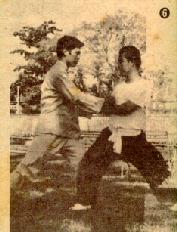
The Flower Set was described and explained in the Classic of Shaolin Kungfu, comprising of 40 volumes and compiled by the Venerable Fu Ju in the year 901 during the Song Dynasty. Shaolin Wahnam members are very lucky that Grandmaster Wong has a copy of this Classic of Shaolin Kungfu.
Grandmaster Wong explains that due to its long history, the Flower Set described in this Classic was different from the versions found in many kungfu schools today and also different from the one we practice in Shaolin Wahnam. Thanks to our Sifu's ability to read classic Chinese writing and his incredible ability to gain energetic and practical understanding through his reading we gain a cosmic insight into this set from the earliest writings available. Incredible!
Reference: Interesting Background of Shaolin Wahnam Kungfu Sets, History and Philosophy of Shaolin Flower Set
Historical lineage as compiled by Sifu Wong Kew Kit
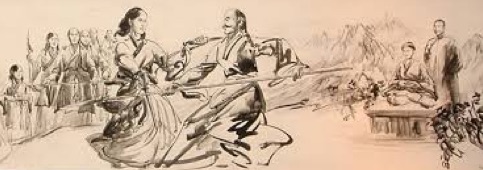
"There were Five Shaolin Grandmasters in the Qing Dynasty. They were Wu Mei, Bai Mei, Zhi Shan, Feng Dao Te and Miao Xian in that order. The names given above are in Mandarin pronunciation; perhaps they are better known in the Cantonese pronunciation, which are Ng Mui, Pak Mei, Chee Seen, Foong Tou Tuck and Miu Hein respectively.
Of the five, Ng Mui was the best fighter. She was a Shaolin nun. Little is known of her early history. Some believe that she was a Ming princess, but renounced worldly life to become a nun.
Others believe that before she became a nun she was the famous female kungfu knight, Lu Si Liang, who single-handedly penetrated the Qing palace and killed the Qing Emperor who earlier ordered the burning of the southern Shaolin Temple at Quanzhou.
Unfortunately differences arose between Ng Mui, Chee Seen and Mui Hein on one side, and Pak Mei and Fong Tou Tak on the other. Politically, Ng Mui, Chee Seen and Mui Hein wanted to overthrow the Qing, whereas Pak Mei and Fong Tou Tak supported the government.
Pak Mei's distinguished disciple, Kuo Chun Chong, was the military commander for the two provinces of Fujan and Guangdong. Led by Pak Mei and with the help of Fong Tou Tak and their followers, Kuo Chun Chong and the Qing army destroyed the second southern Shaolin Temple at Jiulian Shan.
Because she was a nun, Ng Mui did not stay in the Shaolin Temple, which only accommodated monks. She travelled widely, especially in Yunnan Province, but also spent some time at the White Crane Temple in Guangxi (Kwangsi) Province.
Wu Mei's favourite disciples were Yan Yong Chun and Fang Shi Yi, who are certainly better known in their Cantonese pronunciation as Yim Wing Choon and Fong Sai Yoke. Yim Wing Choon, was of course the founder of Wing Choon Kungfu.
Ng Mui's Shaolin Kungfu was both extensive and deep, and she was renown for numerous Shaolin arts like chi kung, the no-shadow kick, snake characteristics, and fast, deceptive movements.
There is a style of kungfu called Ng Mui Kungfu. Ng Mui did not consciously invent this kungfu style, but later generations of kungfu practitioners who inherrited Ng Mui's tradition named this particular style after the famous lady Shaolin grandmaster."
-- Grandmaster Wong Kiew Kit
Ng Mui
The Flower Set is typically attributed to the Shaolin Nun Ng Mui, though there are many variations on her name and story. A typical story describes her study of a crane fighting a snake leading to the development of her style of Kung Fu. The crane is able to strike as defense and counter, one of the specialties of this style. She is also credited with studying many of the animals and/or kung Fu styles prevalent in her day while composing her own unique style.
Ng Mui (Chinese: Wu Mei; Cantonese: Ng Mui) is said to have been one of the legendary Five Elders-survivors of the destruction of the Shaolin Temple by the Qing Dynasty.
She is said to have been a master of various martial arts including the Shaolin martial arts, the Wudang martial arts, Ng Ying Kung Fu and Yuejiaquan, and the family style of Yue Fei. She is also credited as the founder of the martial arts Wu Mei Pai (Ng Mui style), Wing Chun, Dragon style, White Crane, and Five-Pattern Hung Kuen.
She has been associated with various locations, including the Shaolin Temple in either Henan or Fujian, the Wudang Mountains in Hubei, Mount Emei in Sichuan, a supposed White Crane Temple, the Daliang Mountains on the border between Sichuan and Yunnan, and additional locations in Guangxi and Guangdong. According to one folk story, she was the daughter of a Ming general.
Wing Chun
According to the Wing Chun master Ip Man, Ng Mui was residing and studying at the Henan Shaolin Monastery; she managed to survive its destruction by Qing forces during the reign of the Kangxi Emperor (1662-1722). She fled to the White Crane Temple. (which this account locates in the Daliang mountains between Yunnan and Sichuan) where she met a girl of fifteen named Yim Wing-Chun whom a bandit was trying to force into marriage. Ng Mui taught Yim Wing Chun how to defend herself by distilling Shaolin martial art knowledge into a system that Yim Wing Chun could learn quickly, and use without developing great strength.
There are a few good reasons the aforementioned story may not be accurate according to Sifu Wong.
(a) The Henan Shaolin Monastery was meant for monks, and it would be inappropriate for a female to stay there.
(b) It is a historical fact that the Henan Shaolin Monastery was burnt in 1928, 17 years after the fall of the Qing Dynasty.
(c) The words in Chinese which means "The Shaolin Monastery" was written by Kangxi Emperor.
(d) The Henan Shaolin Monastery practiced Northern Shaolin Kungfu. Ng Mui practiced Southern Shaolin Kungfu, which is characteristically different from Northern Shaolin Kungfu.
(Grandmaster Wong Kiew Kit)
Five-Pattern Hung Kuen
It is believed that the Five-Pattern System was jointly created by the Buddhist nun Ng Mui, and Miu Hin, an unshaved disciple of the Shaolin Monastery Monastery. Through careful observation, and imagination, these two kung fu experts imitated the movements of the creatures -- how they jump, how they paw, and how they use their wings, beaks, jaws, or claws, how they coil up, how they rush forward and retreat, and finally they created this kung fu system consisting of movements modified from those of the named creatures, and adjusted the techniques to suit human limbs.
-- Leung Ting, Five-Pattern Hung Kuen, Part I. (1980) Dragon style
Modern Dragon style historians relate that Shaolin nun Ng Mui, who is said to have originated the Dragon style, was one of the last members of the temple before its first destruction, which they date to 1570 (Chow & Spangler, 1982). The Shaolin Gung Fu Institute of the Pacific Northwest agrees with the date of 1570 for a destruction of the temple and states explicitly that Dragon style was created at the Henan Shaolin Temple c. 1565.
According to Sifu Wong, 1570 was too early for Ng Mui to have lived.
Wu Mei Pai
In the Wu Mei Pai tradition, Ng Mui -- the daughter of a general in the Ming imperial court -- fully developed her practical style in the Forbidden City. To develop balance and leg strength she trained on upturned logs, in a pattern she invented. She was traveling when her parents were killed in the Manchu capture of the Ming capital. She took refuge in the White Crane Temple (which this legend locates in Kwangsi Province), and became an anti-Qing rebel, teaching her style only within the Temple. The style uses instantaneous counters, and slower movements from Bodhidharma and Qigong.[3][4]
White Crane
According to the genealogy of Tibetan White Crane, "Ng Mui" is the Chinese name of the Tibetan monk Jikboloktoto, who was the last generation of transmission before Sing Lung, who brought the art to Guangdong. This account is most different from the others, with a male Ng Mui, the absence of a Manchu menace to flee from and, given the dating of Sing Lung's relocation to Guangdong to 1865, a 19th-century setting.
Reference: Ng Mui, Wing Chun, Five-Pattern Hung Kuen, Dragon, Wu Mei Pai, White Crane
Fong Sai Yoke (from shaolin.org)
"Fong Sai Yoke was one of the ten great disciples of the Venerable Chee Seen, the First Patriarch of Southern Shaolin Kungfu. His style was of course Southern Shaolin which he learned at the secret southern Shaolin Temple on the Nine Lotus Mountain in Fujian Province of China. He specialized in the Shaolin Flower Set, and his specialty was the Organ-Seeking Kick. He was often known as Len Chye Yoke, or "Handsome Yoke".
When Fong Sai Yoke was still an infant, his mother, Mui Chooi Fa (who was also one of the ten great disciples of the Venerable Chee Seen), conditioned him with a herbal concoction. She held the infant by his head and groin, and soaked him in a basin of the concoction. Hence, these were the two parts that were not conditioned, and later proved to be fatal to Fong Sai Yoke.
After soaking, his mother would hit him all over with a hard wooden stick, training him in an art called "Copper Skin and Iron Bones". Thus, Fong Sai yoke could take strikes on his body without sustaining injury.
Fong Sai Yoke became famous when he killed a kungfu master named Looi Tai Pang, who was nick-named "Tiger Looi". Tiger Looi set up a "Plum Flower Formation" in Guangzhou (Canton) to challenge any kungfu masters to fight with him. This "Plum Flower Formation" was made by poles driven into the ground in a pattern of plum flowers, and combatants would fight on top of the poles.
On both sides of the Formation was hung a poetic couplet to insult the martial art circles of Guangdong Province and the cities of Suzhou and Hangzhou as follows (in Cantonese):
khun ta kong tung yeit shang
kuoik thet su hong leong chow
which means:
Fist to whack the whole of Guangdong Province
Kick to sweep the cities of Suzhou and Hangzhou
But Tiger Looi was such a formidable fighter than no one could match him. Many were injured and some were killed by Tiger Looi in the challenges.
Fong Sai Yoke's father, Fong Tuck, knew that his son would take up the challenge. To avoid trouble, he locked his son up in a room, but Fong Sai Yoke broke loose and fought with Tiger Looi.
Although Tiger Looi was huge and muscular, he was killed by Fong Sai Yoke with a strike on the solar plexus using the pattern "Black Tiger Steals Heart". Fong Sai Yoke was only 15 years old at that time. He instantly became famous.Tiger Looi's wife was Li Siu Wan, the daughter of Li Pa San, who was the First Patriach of Li Family Kungfu. Li Siu Wan challenged Fong Sai Yoke to an open duel. Although Li Siu Wan was an elegant lady, she defeated Fong Sai Yoke using "chiun sam thoui", or "through-the-heart kick".
Fong Sai Yoke could have been killed had his mother, Miew Chooi Fa (Miu Chui Fa), not insisted that he wore a "protection mirror" on his chest. The protection mirror, which was made from strong but light metal, was badly damaged by a kick from an elegant lady, and Fong Sai Yoke despite the protection was internally injured.
Miew Chooi Fa challenged Li Siu Wan, and defeated her with a No-Shadow Kick. Then Li Siu Wan's father, Li Pa San, challneged Miew Chooi Fa.
In kungfu herarchy, Li Pak San and Miew Chooi Fa were "kungfu cousins", because Li Pak San's teacher, Pak Mei, and Miew Chooi Fa's teacher, Chee Seen, were "kungfu brothers". But Li Pa San was much older, about the age of Miew Chooi Fa's father, and his kungfu ability was also much higher. Miew Chooi Fa would be no match against Li Pa San, and could be killed should the challenge go on.
This series of challenges and counter-challenges could go on and on. Happily, the famous Shaolin nun, the Venerable Ng Mui, who was highly respected in kungfu circles and who was also the best fighter at the time, stepped in to stop the continual fightings. Ng Mui was the senior kungfu sister of Pak Mei, therefore was the Sipak of Li Pa San. Faced with the possibility of having to meet Ng Mui in a duel where he knew fully well he would be easily defeated, Li Pa San wisely withdrew his challenge to Miew Chooi Fa.
As a punishment for Fong Sai Yoke, Ng Mui took him away to be "imprisoned" in her temple for three years where he had to meditate and repent. This turned out to be a blessing in disguise for him as he had a rare opportunity to be couched by Ng Mui in his kungfu training.
It is illuminating to note that in genuine kungfu, age, size and gender do not matter in combat. Tiger Looi was huge, and Fong Sai Yoke was small-sized and only 15, yet Fong Sai Yoke killed the Tiger with a single punch!
This tiger-killer was badly injured despite wearing a hidden armor from a kick by an elegant lady, Li Siu Wan. Yet, Miew Chooi Fa who defeated Li Siu Wan was no match against Li Pa San, a man her father's age. But the best fighter of all, one whom the First Patriarch of a kungfu style would choose not to face, was an elderly nun."
-- Grandmaster Wong Kiew Kit

Special Skills for Combat Application
Two special features of the Flower Set are the "flower hand" and the "organ-seeking kick". These may be continuous kicks and attacks that may be false or true depending on the opponents responses.
We also see the skill of attacking above and below simultaneously to further confuse opponents and enjoy the advantage of striking with whichever strike the opponents fail to respond to.
With the Flower Set we can confuse our opponent with techniques like this or with our speed. Flowing force can generate tremendous speed and when combined with continuous attacks can leave an opponent stunned and unsure where the attack even came from! By speedily abandoning a strike that our opponent responds to while simultaneously flowing into the same strike again, like sweep a thousand armies and leaking hand, we can simply be too fast for the opponent to respond to.
It is the deceptive movement and incredible speed that make the flower set worthy of so many no defense direct counter techniques.
There are many advanced skills to be seen in the flower set such as:
- starting later but arriving earlier
- running defense and counter techniques at the same time
- striking your opponent when his old strength is spent but his new strength has not been created
- Taming two with one and simultaneous taming and striking.
The Flower Set we practice in Shaolin Wahnam is divided into two sections, "ta chong" or force training on stance, and "ta sei moon" or combat sequences in four directions. The first time Grandmaster Wong revealed the secrets of the Flower Set was at the Winter Camp of 2010 in Finland.
Force Training Set 1
Flower Set force training is truly amazing. So many of the high level skills utilized for combat in the Flower Set require the tremendous force and Mind created by these force training methods.
The force training in Flower Set is comprised of 8 sequences with four done in one direction and the next four completed in the opposite direction. They are separated by a small sequence to develop fast attacks using a high, low then middle attack strategy as well as a single pattern sequence to develop a flower set style counter attack as defense ending with a throw.
Video: Force Traing of Flower Set
Pattern 1
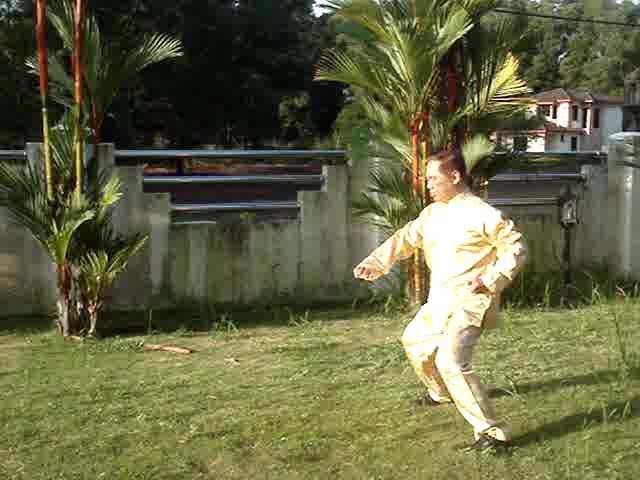
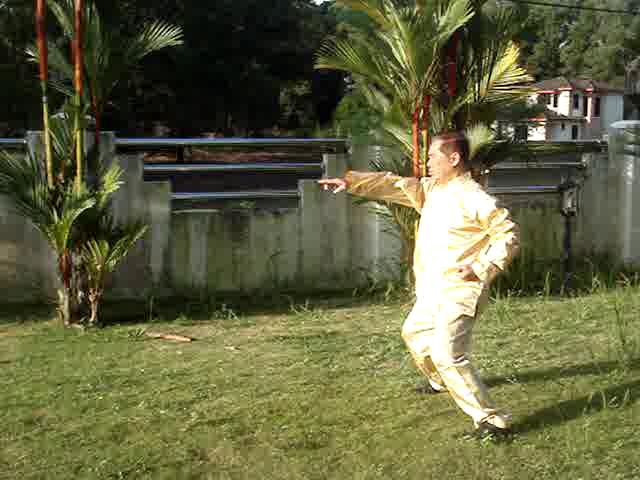
Two-Finger Shooting Zen
Composed of
- Single Planting of Flowers
- Beauty Looks at Mirrow -- dragon hand
- Single Dragon Emerges from Sea
- Rolling Tunder Overturns Sky
Two-Finger Zen is the engine to develop a powerful radiating type of force that is necessary to successfully acquire and utilize the force from the Double Worshipping of Buddha.
Two-Finger Shooting Zen focuses energy at the two fingers, but particularly at the middle finger, and is frequently used for Dim Mark.
Videos: Shaolin Flower Set
Pattern 2
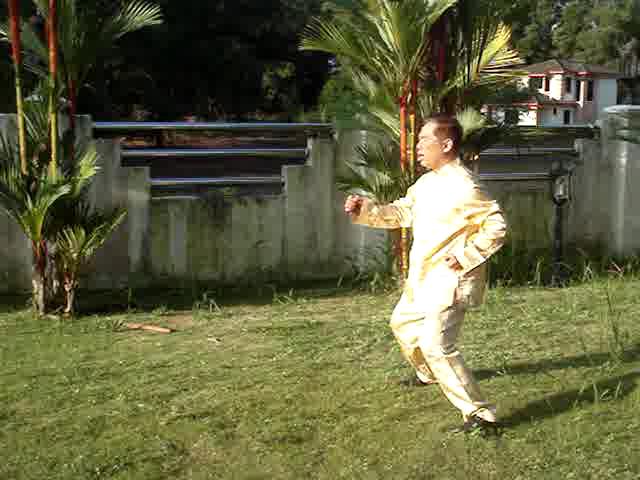
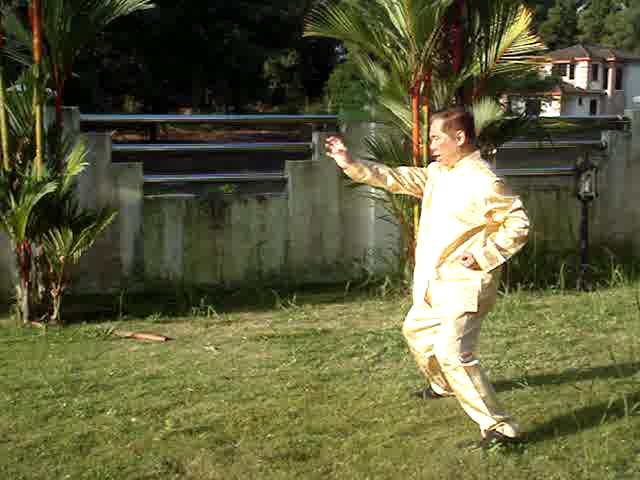
Composed of
- Big Boss Offers Wine
- Single Tiger Claw
My personal experience training the pattern Big Boss Offers Wine and Single Tiger Claw using the Flow Method of the Flower Set seems to give a glimpse of obtaining the skin of the Marvelous.
At times it may feel as though there is the thought of beginning the technique and with almost no time elapsed the punch arrives in front of me. From thought to reality without regard to space and time.
I believe this is included in so many sets as it develops the marvelous skill for our most basic attack and defense - Black Tiger and Single Tiger.
Pattern 3
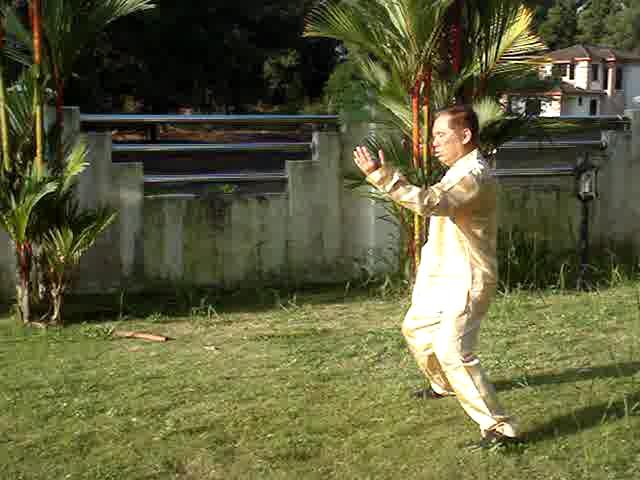
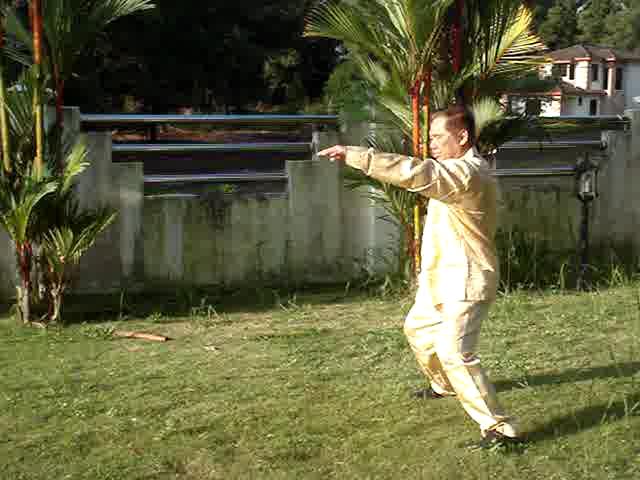
Composed of
- Beauty Looks at Mirrow
- Horizontally Sweep a Thousand Armies
Of all the force training methods found in this set this one is the best for developing the Flow Method.
Practicing this in a very flowing manner eventually leads to the incredible speed and force needed to apply the special leaking technique using Horizontally Sweep a Thousand Armies found in the second sequence which follows the last force training section.
Another example of how defense in the Flower Set translates into immediate attack in a flowing manner emphasizing speed as well as false and real technique.
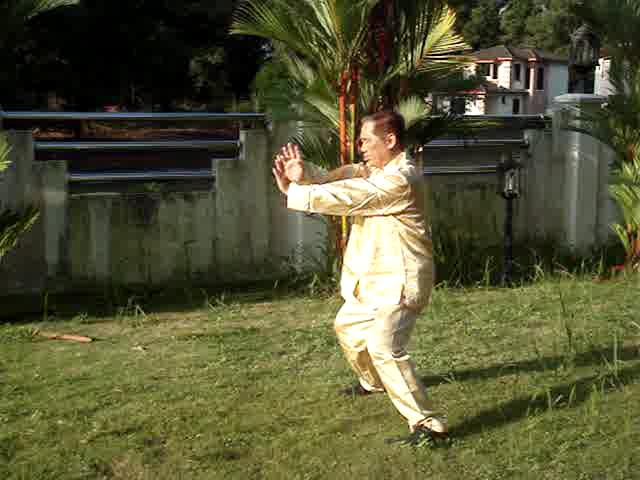
Composed of
- Lower Scissor Hands
- Double Worshipping of Buddha
The coup de grace of the Flower Set Force Training, this pattern requires tremendous internal force already be present to achieve the skills found here
For one, you can utilize this technique to draw energy in and explode either downward or forward as well as from the palms, the chest or the entire body!
This is at once a technique for developing internal force as well as developing the Mind skill needed to obtain ultimate control of flowing force into consolidated force anywhere in the body.
I believe this technique can aid us in the development of Cosmos Palm and the ability to confuse the Shen of our opponent with an overwhelming explosion of Force. Most interestingly this technique is an almost perfect combination of flow method training and consolidated training - we flow through the movement and consolidate at the very end with either a precision explosion of force that seems multiplied by a factor of a thousand after the gentle flowing movement.
Video from St Pete Courses: Double Worhipping of Buddha in Legacy of Shaolin
See Combat Application: Combat Application from Double Worshipping of Buddha to Upper Elbow Strike
See Combat Application: Double Worshipping of Buddha in Legacy of Shaolin
Personal Note
I personally experienced the power of this technique at the Special Combined course in Sabah. After receiving a Wudang Mind Level transmission from Sifu we set out to do some force training from our individual sets. I chose the Double Worshipping of Buddha on a whim because I never really felt much power from it while practicing at home.
After just a few flowing repetitions of the movement I exploded force three times. Each time was multiplied by a thousand times the sensation of force and with each repetition I could feel my force hitting the walls of the hall making a boom sound each time and after the last repetition it seemed that time stopped.
Momentarily unaware of the rest of the room I simply stood and realized I could feel every mote of energy in the room and actually visibly see millions of fine particles floating all around me. I knew in an instant I was seeing another layer of cosmic reality but at that time didn't have any words or true understanding of what I could see.
Regardless as I let go completely into Chi Flow I was suddenly filled with so much energy I was certain I could run out of the doors and run up trees and jump from tree to tree as effortlessly as a monkey. I almost did it then my own reality crept in and I settled for tearing around the room screaming instead!
Thank you Sifu for another tremendous glimpse of our true potential! Ever since this moment this technique has come more and more alive with every practice session and I can only imagine just how far it may take me!
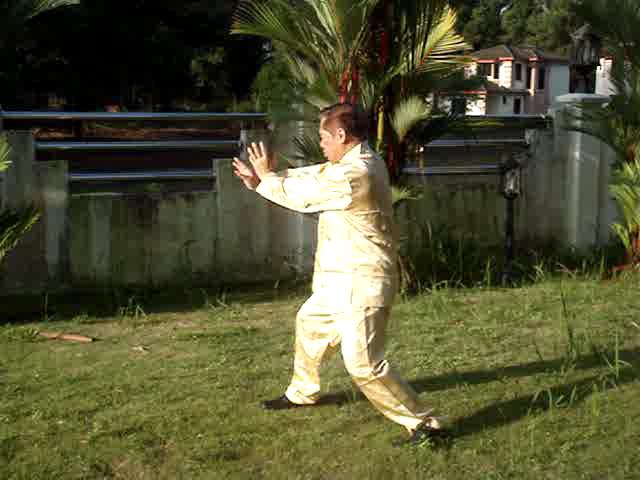
Flowers blossoming Left and Right
Following the first four Force Training Sets we have the Right and Left Step Blossoming Flowers. These can be utilized to train the leaking hand, the grip release and the release and strike skills backed up by the flow then force of the Double Worshipping of Buddha.
First Sequence
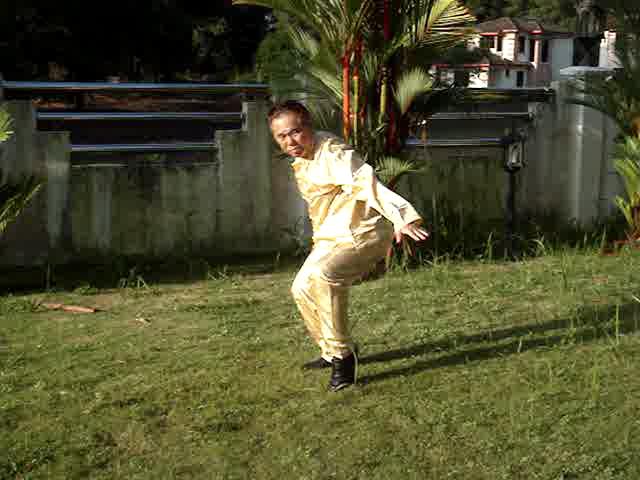
Composed of
- False Leg Hand Sweep
- Poisonous Snake Shoots Venom - high attack
- Precious Duck swims through Lotus - low attack
- Black Tiger Steals Heart - middle attack
This is an excellent sequence to use to develop a fast and flowing movement through the three levels of attack. I believe at a higher level it can be used to counter any counter by immediately changing levels and striking as soon as the opponent counters the first strike. It is also very useful to use as a pressing attack while continuously throwing your opponent off by changing the level of attack fluidly.
Transition Sequence
Composed of
- Precious Duck Swims Through Lotus
- Fell Tree with Roots
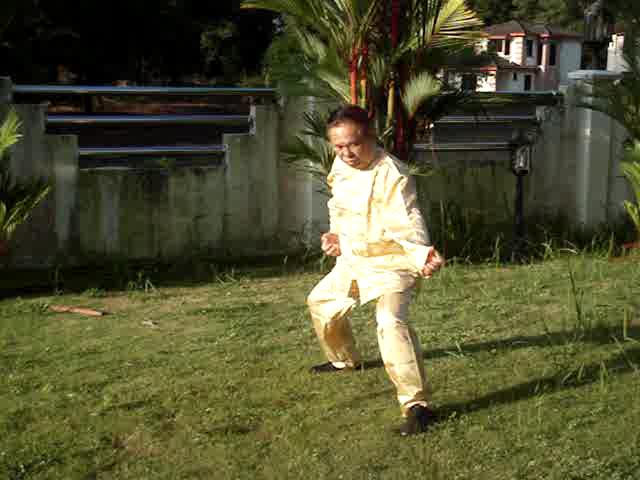
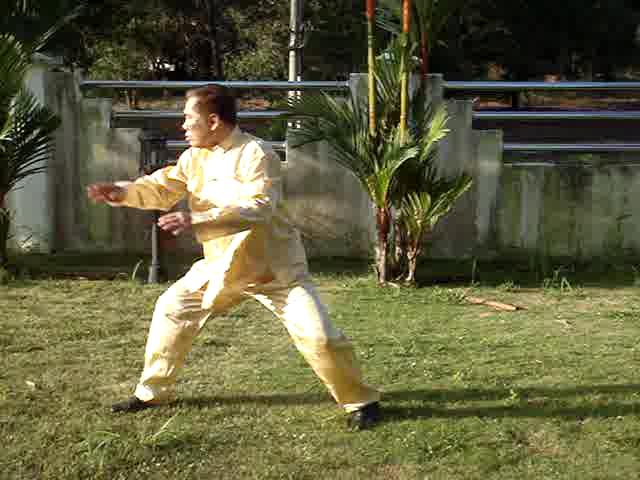
In Precious Duck Swims through Lotus we avoid an incoming attack sliding right in and moving in to the throw. We must be sure to guard well and we may use the bridge to slide in to the throw.
Check out the video from Finland: Flower Set: Swimming Dragon
Force Training Set 2
Composed of
- Big Boss Offers Wine
- Single Tiger Claw
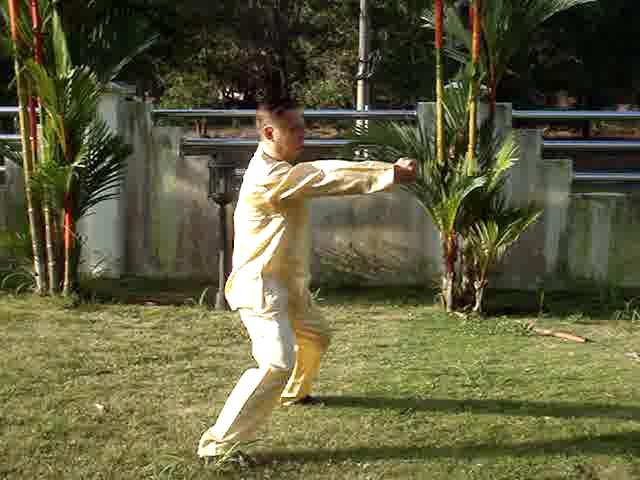
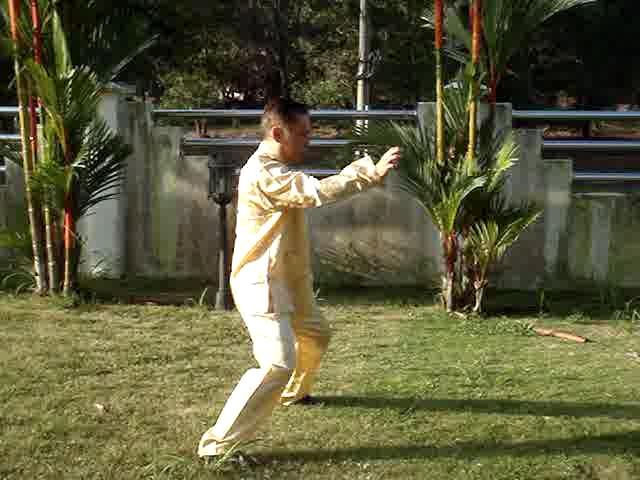
My personal experience training the pattern Big Boss Offers Wine and Single Tiger Claw using the Flow Method of the Flower Set seems to give a glimpse of obtaining the skin of the Marvelous.
I believe this sequence is utilized twice to emphasize the importance of training our most basic and versatile techniques for attacking and defending.
This is also the only Force training for Tiger Claw in the Force Training section.
Composed of
- Reverse Hand Pluck Fruit
- Single Dragon Emerges from Sea
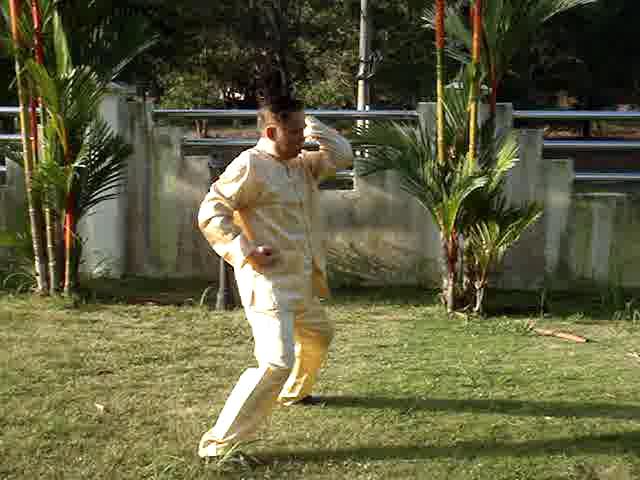
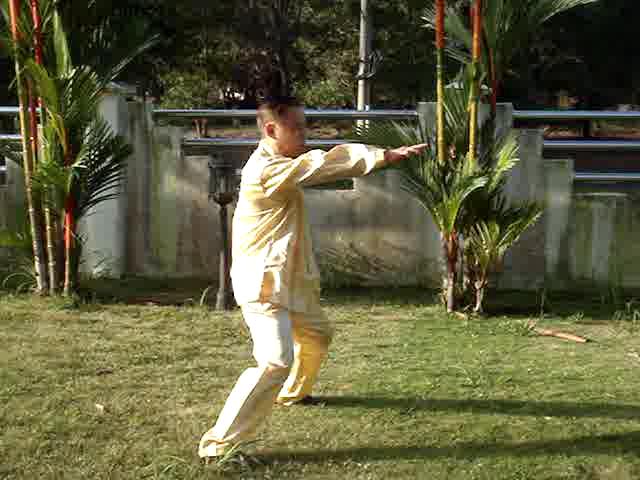
A wonderful technique for injuring an opponent who has gotten to your back. A direct and effective strike to the eye or throat can be a sparring ending move.
Utilizing the flow method during this force training enables you to have a fast and effective technique to stab behind you.
With Single Dragon we release force for the strike which can be Dim Mak practice.
Personally I find this is a powerful exercise to open the energy flow and flexibility in the arm and shoulder.
Composed of
- Phoenix Flaps Wings
- Reverse Hanging of a Golden Lotus
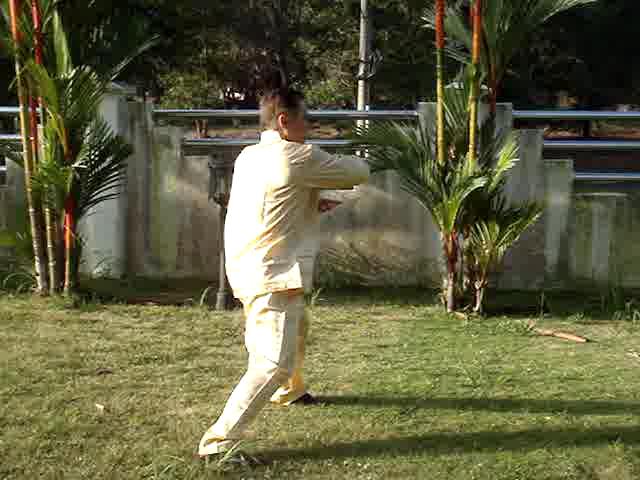
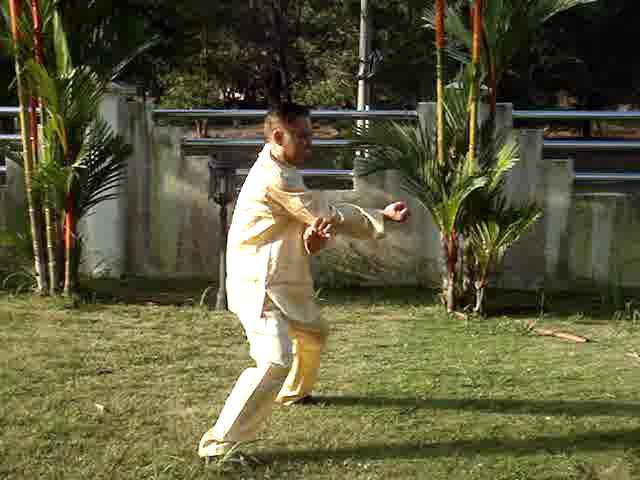
An excellent set for developing good waist rotation while applying close combat flower set techniques.
My favorite part of this force training is the feeling that the threading hand is as powerful a strike potential as the backlist itself.
Composed of
- Double Dragons Embrace Moon
- Double Dragons Emerge from Sea
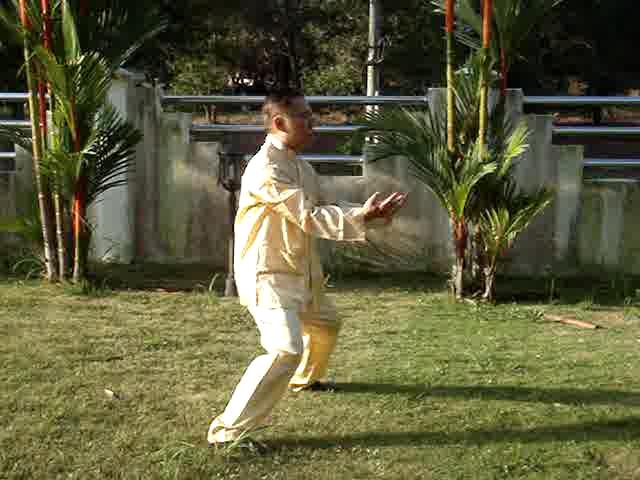
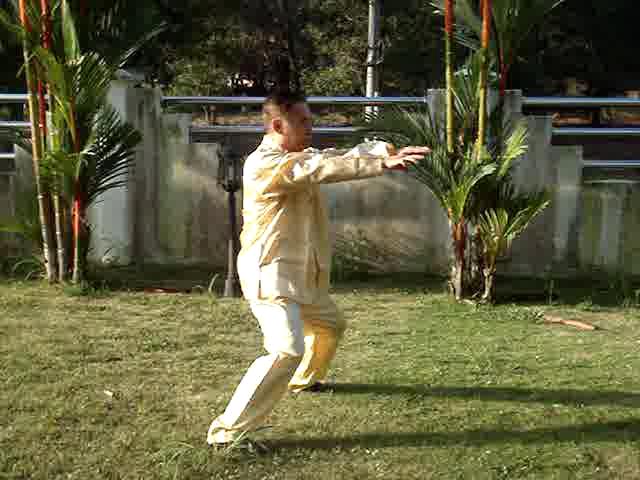
A truly powerful way to develop the same power and flow down both arms at the same time.
This force training shows up in so many of our sets in Shaolin Wahnam that I can only imagine how highly it has figured in Sifu's own training. I also imagine it appears at the end of the section as it is likely one of those force training methods that improves and opens up new levels over time.
The drawing in of energy to Dan Tian and explosion out in Double Dragons feels like Mind level training to control Chi.
Open Door Left and Right
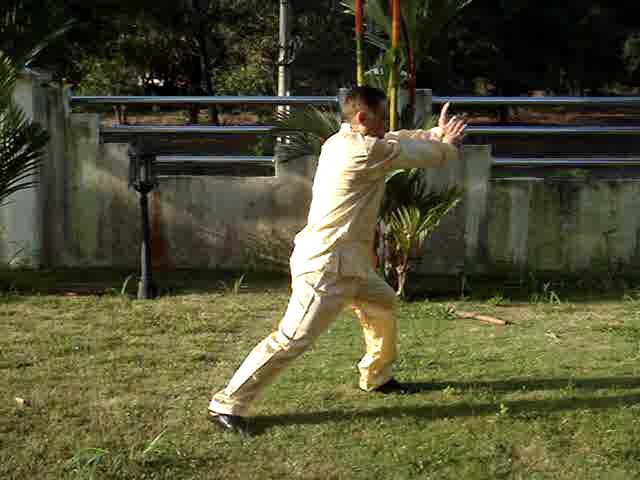
Butterfly Palms to the left and right sides.
Masterfully defend against kicks, throws and attacks with the Marvelous Butterfly Palms while attacking compassionately by throwing the opponent away or upping the ante and grabbing and twisting.
Second Sequence: Trim Bamboo, Sweep and Thousand Armies and Double Butterflies Flying
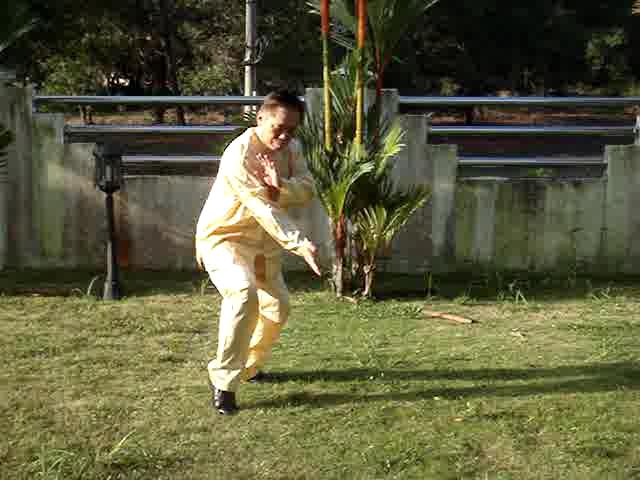
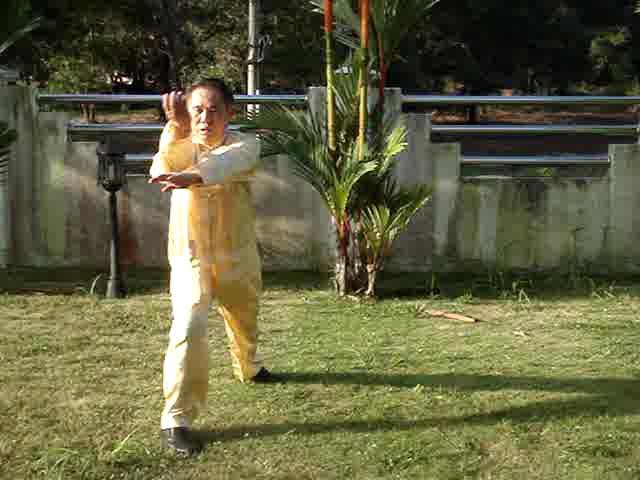
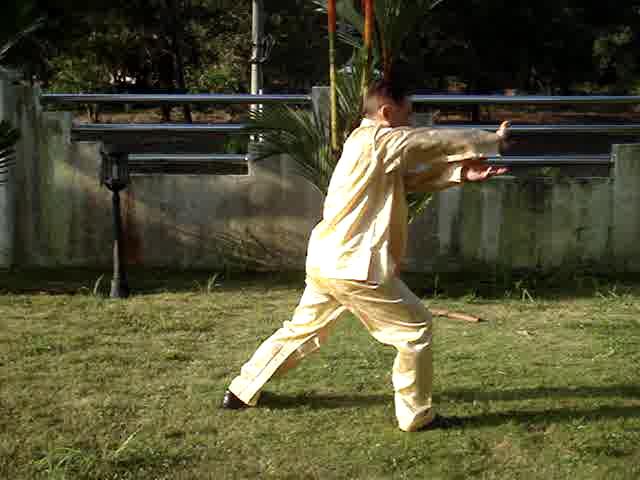
One of the most effective combat sequences in the Flower Set this sequence gives us many essential elements of the Flower Set skills.
Trimming Bamboo is both strike and defense simultaneously.
Sweep a Thousand Armies used with speed and continuous flowing movement one after the other creates a pressing attack that is so fast from one strike to the next there is almost no chance for the opponent to successfully defend it.
Double Butterflies Flying can strike while defending two arms with one.
Section 2: Combat Sequences in Four Directions
The combat sequences in our Flower Set offer the best of the best in terms of Combat Application. These are game changing, fight ending sequences full of the marvelous. The structure of building in practice in all four directions lends itself to a truly complete practice as well as the development of sparring against multiple opponents.
Moving through one sequence in all four directions lends itself to building flow with each sequence with no inherent pause between sequences -- there is the feeling of no beginning and no end as though you could flow through each sequence a million times in any direction.
Sequence 1
Swimming Dragon Plays with Water and Hang a Golden Star at Corner.
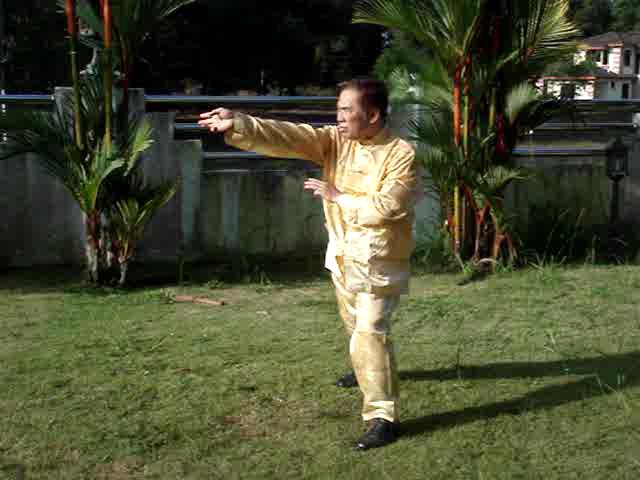
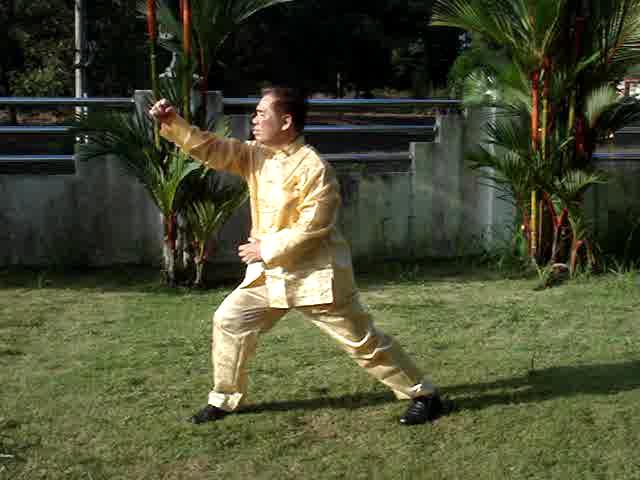
In the first sequence we utilize a sideways bow and arrow stance to be able to attack to the side of our opponent's strike. This is an excellent variation allowing us to essentially conquer the idea of striking at the point their energy is spent and using our footwork to avoid the attack.
These are excellent techniques to practice actually applying Dim Mak. A hit to the armpit or rib area of the liver can have significant consequences if the strike is internal and these points are closed. This is a wonderful example of avoiding a strike while landing our own strike.
Three golden stars is another opportunity to practice the flowing speed of the Flower Set and overwhelm an opponent so that it feels like strikes are coming from multiple directions at once. With the speed of this set this attack can be devastating.
Swimming Dragon also feels as though it is excellent practice for dealing with multiple attackers as it can be adjusted to so many different angles depending on how attacks come at you. The sideways bow and arrow can also taunt an opponent by appearing to be undefended at the groin.
Sequence 2
Chop Hua Mountain and Big Boss Offers Wine
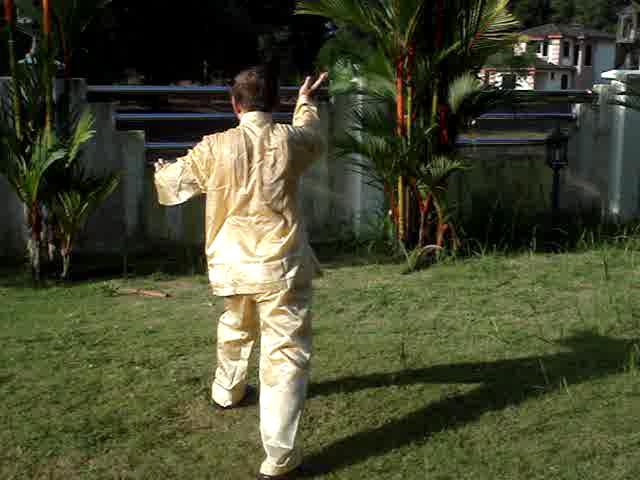
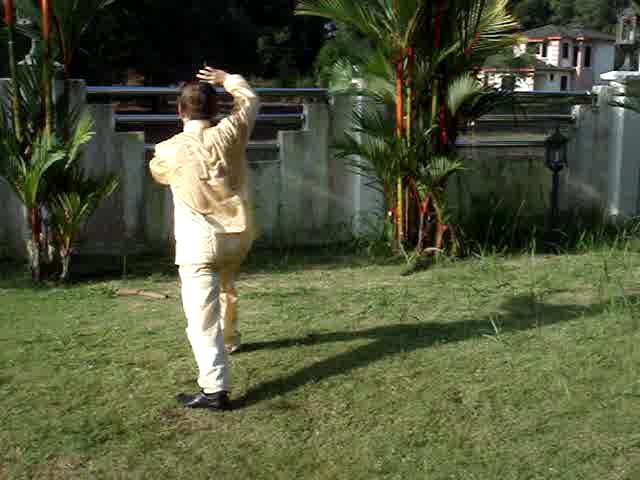
Sequence 2 shows off some wonderful skills, most notably taming two arms with one and pressing the attack. With Chop Hua Mountain we get the opponents hand to come up to block and can immediately move in taming both of their arms and striking at the solar plexus or Dan Tian.
The initial threading movements can be practiced continuously in flow method before moving onto the rest of the sequence to help develop the tremendous speed and precision needed to use the Golden Dragon as both defense and attack at once. I also like to practice multiple thread hands until my imaginary opponent "moves the way I want" then I suddenly explode forward into Chop Hua Mountain and lock up both arms ending with an internal strike to the solar plexus with a cup fist or phoenix eye to the throat.
The Flower Set sequences are wonderful to exchange hand forms for the final strikes to play with distance spacing or to alternate what level of the body the final strike will land. As a short person I often vary the middle strike to something more appropriate for the groin as that is often a middle strike for me!
This is one of the best sequences to work on the flow and sudden speedy explosion into force or pressing attack.
Sequence 3
Golden Leopard Enters Rock and Rising Dragon Galloping Tiger
On Ground Strike Tiger and Double Continuous Kicks
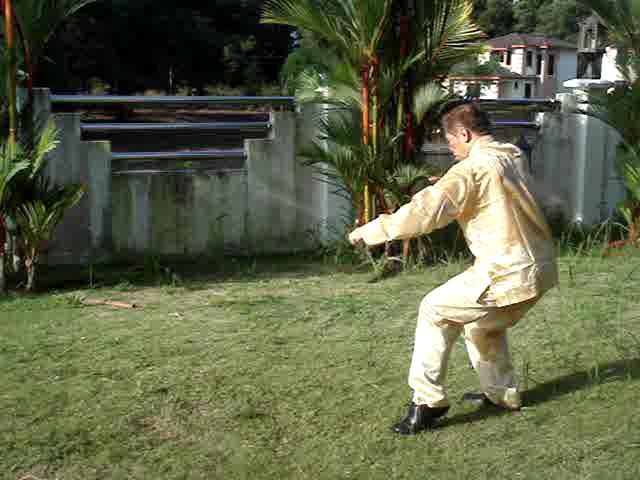
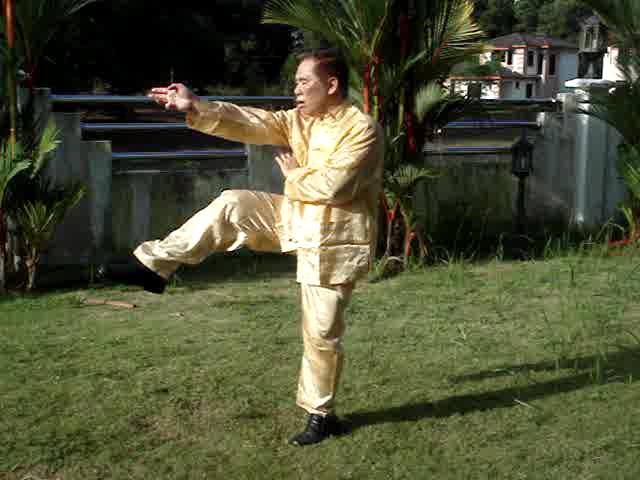
The third sequence brings us the skill of getting to our opponent's back. Deftly swiping away strikes and using a smooth flowing speed to flow behind your opponent to deliver a leopard punch to the ribs or kidney is an amazing way to gain the upper hand. Even if your opponent counters well you are ready to continue pressing in with a strike and kick delivered simultaneously so that either strike can be false or real depending on how the opponent counters.
Again this is an excellent sequence to work on the flow method and the speed bursts that Flower Set can deliver. Again we have defensive moves like Kitten Wipes Face that can use the technique of cloud hands to confuse our opponents in a swirl of movement that can be defense or attack depending on our opponents. If they are slow our swipe may include actually swiping their face or eyes or can mask the sudden flowing movement as we gain their back.
Kitten Wipes Face is also an excellent pattern to wipe away a boxers jabs, as this technique will flow with the opponents momentum.
Combat Sequences in Flower Set for Legacy of Ng Mui Course
Sequence 4
On Ground Strike Tiger and Double Continuous Kicks
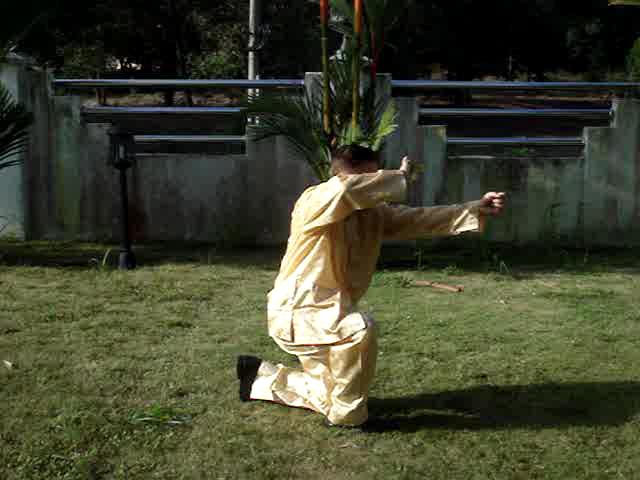
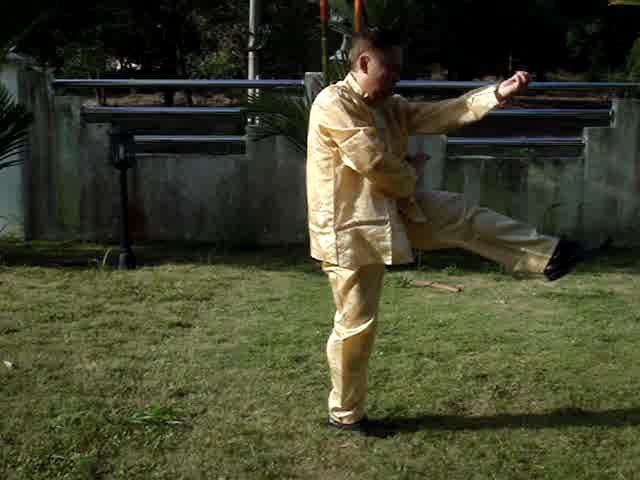
In the fourth sequence we have the coup de grace of the Flower Set. The Double Continuous Kicks are tremendous. It is possible to actually defend an opponents kick with your first kick (striking a bit) then immediately following up the second kick to fully take the opponent down.
This is another amazing manifestation of no defense direct counter and overwhelming speed of continuous strikes that is a hallmark of the Flower Set. Simply leaving no space for the opponent to attack you and taking a pressing attack to the next level.
Using On Ground Strike Tiger as a kick defense or to change levels to confuse your opponent is another great Flower Set strategy. This also reminds me of a move one might use with multiple opponents -- as someone comes from behind to kick, grab or strike you can swiftly turn, drop down using the vertical shift as defense while landing a strike to the groin almost as soon as you use the movement to defend. Done fast and expertly even this move could be used as no defense direct counter though technically the defense is in shifting the stance downward.
Check out these old photos of Sifu demonstrating a Flower Set Combat Sequence!!! Combat Application of the Shaolin Flower Set
Video Series of whole set: Shaolin Flower Set
Ending Sequence
Return Head Hand-Sweep
Black Tiger Steals Heart
Show Dragon Hide Tiger
Tame Tiger Subdue Dragon
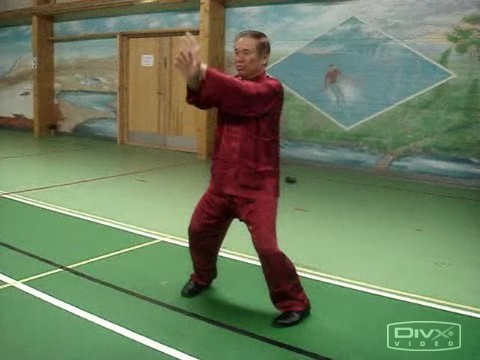
-
Mut yu mui fa thuei thuei hoi
Kap foong po yu khun wan loi
Blossoming like plum flowers in full gear
Swift wind rain storm clouds flowing here
Hopefully by now we can begin to glimpse the beauty in this poem.
The Double Worshipping of Buddha gives us this marvelous skill of strikes exploding and appearing almost out of nowhere. Like the beautiful plum flower blossom suddenly explodes out of the barest branch of tree.
The soft wind and flowing clouds is the beauty of the flow method showing itself in flowing around the back of an opponent or flowing around their strikes so that one never retreats just flows around the opposition and into position arriving like the rain as a matter of course. Even in all that flowing movement and cloud formation the sudden strike of rain and lighting is there. As the flow method reaches its apex the force consolidates more and more so that there is the sudden explosion of the breaking storm.
This shows us that speed and power with deceptive, explosive and precision movement are the main skills we embrace as we practice this beautiful set. There is no stopping the storm nor anticipating where or when its lightning will strike.
Extra links
Christina Didyk
Dec 22nd, 2018.
LINKS
